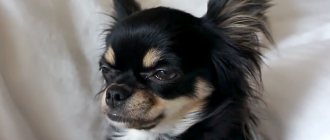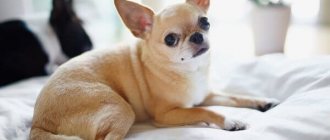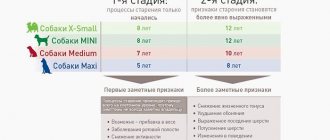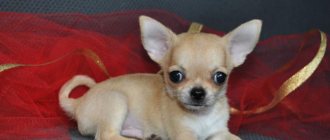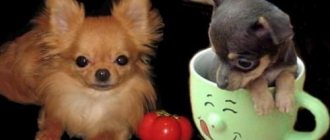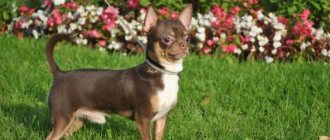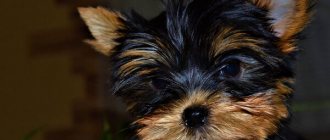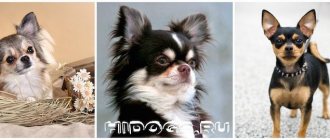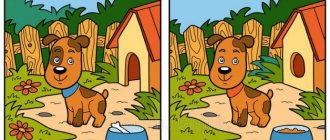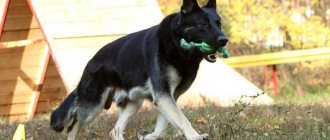Breed characteristics
| Short description | |
| Origin: | Mexico |
| Conditions of detention: | Apartment, house without garden |
| Purpose: | Decorative dog, companion dog |
| Color: | Sable, black, black and white, brindle, chocolate, black and tan |
| Wool length: | Short or medium length |
| Adult dog size: | Height – 17-25 cm, weight – 500 g-3 kg |
| Average life expectancy: | 15-20 years |
| Walk: | Walking twice a day is recommended |
| Physical activity needs: | Low physical activity needs (20-40 minutes of walking per day) |
| Fédération Cynologique Internationale (FIC) classification: | Group 9: Toy and Companion Dogs, Section 6: Chihuahuaenos |
| Puppy price: | From 10,000 to 60,000 rubles. Without pedigree - 10,000-12,000 rubles, pet class - up to 30,000 rubles, breed class - 40,000-45,000 rubles, show class - approximately 60,000 rubles |
Description of the breed
The Chihuahua became known as the smallest one in the world, bred without the help of breeders. The description of the Chihuahua breed proves that it combines the features of the Techichi and other breeds with which matings took place. The blood of modern representatives of the breed combines the genes of Pinschers and Terriers, Spitz and Papillons. The babies have a long body and are short. A distinctive feature of the animal is its rounded head and short but sharp muzzle.
Photo from Wikipedia website
Chihuahua puppies are distinguished by a small, soft-to-touch spot at the top of their skull. As the animal grows, the spot sometimes heals and sometimes it doesn’t. The color of a dog's eyes depends on the shade of its coat, which can be straight or wavy, short or long. Features of the Chihuahua are a rich variety of coat colors and a thin sickle-shaped tail.
Main characteristics
Representatives of the breed are divided into several subspecies according to their physique: cobbies - low, massive, stocky with a short, underdeveloped muzzle; dir - lean with wavy hair, a small head and a long muzzle, similar to a fawn;
- long-haired;
- shorthaired
There is a classification of dogs by weight, since they can weigh 0.6 – 1.8 kilos (mini), 1.8-3.5 kilos (standard). After studying the description of the Chihuahua breed (standard or mini), it becomes clear that a weight of less than 600 grams is a pathology that must be dealt with as soon as possible.
Photo from Wikipedia website
A variety of color options and their combinations are allowed, including:
- black and black and white;
- chocolate and black and tan;
- brindle and sable.
There are also the most unpredictable shades, including peach, lilac and even blue. Thanks to its compactness, the animal easily adapts to cramped conditions. Descriptions of the Chihuahua's character and appearance indicate that they can exist calmly even in a small dorm room.
Appearance
In the twentieth century, standards for this breed were developed. The description of the Chihuahua dog indicates that the adult looks like a small, playful dog with a hopping gait. You need to take a closer look at what a Chihuahua looks like in order to choose a purebred animal. It has a short, pointed snout, which can lead to dental and oral problems. The color of the nose varies from beige to black with splashes of pink, red, and brown. The shade depends on the coat color of the animal.
A special feature of the Chihuahua breed is its large, bulging eyes that glow. There are dark and light eyes, and the shade depends on the genes. The ears, large in comparison with the head, are rounded at the ends and sometimes droop. There is no need to crop the ears - they rise on their own by six months.
The characteristics of the Chihuahua prove that its body is slightly longer in relation to its height. The front legs are equal to 1/2 the height of the animal, and its back is strong and level. The pet has straight and muscular limbs, with the elbows located close to the body.
The tail cannot be docked either; as a rule, it is thrown up and bent to the lumbar or side area. To understand why the Chihuahua dog breed is preferred, the description of the breed needs to be looked at as carefully as possible. The highlight is the elastic and energetic gait; the animal walks with its head held high.
Character
The character of the Chihuahua dog is brave, so they are good guards, despite their miniature size. The courage and loyalty of a pet are often intertwined with insurmountable jealousy towards the owner. The complex nature of the animal allows it to make excellent contact, subtly sensing the mood of the owner. He can lie quietly in one place while the owner does not pay attention to him, but at any moment he can turn into an energetic fidget.
The characteristics of the Chihuahua breed allow you to decide how to raise your pet. The baby gets tired quickly and sleeps a lot, but he is not too affectionate with strangers. The animal chooses its owner, who turns into a leader for it. The character and characteristics of the Chihuahua cause some difficulties in training, since they are not very smart.
History of the origin of the species
The homeland of miniature dogs is sunny Mexico, namely the state of Chihuahua, after which the breed was named. The exact time of appearance is unknown, approximately 4-5 century AD.
Long-haired little Techichi were found and tamed by the ancient Toltec tribes. Back then, wealthy Indians kept several dogs in their houses. There is a version that they were mute. One way or another, pets were used for religious purposes. It was believed that they carried the souls of the deceased to another world, so when the owner died, the dog was mummified and buried with him.
In 1850, an American archaeologist found figurines, mummies and rock paintings of Techichi in the temple of Montezuma (Mexico), similar in appearance to modern Chihuahuas.
A few centuries later, Mexico was filled with the Aztec and Mayan tribes. They became the new masters of Techichi. People still honored dogs and used them for religious purposes. The nightmare for the dogs was that now they were not only mummified, but also eaten.
At the beginning of the 16th century, the conquistadors conquered Mexico and the Techichi population declined sharply. Animals were killed and eaten. In addition, the Chinese Cresteds, who arrived on ships with people, mixed with Techichi, the breed changed its appearance. The smartest individuals fled to the forest, where they lived in isolation until the 19th century. Most likely due to this brutal attitude, Chihuahuas are aggressive towards strangers and children.
In the years 1870-1890, Mexicans found cute little dogs in the forest and decided to sell them. Delighted Americans bought baskets of Chikhov on the Mexican border. In 1884, the first breed exhibition was organized in Philadelphia. In 1904 the dog was entered into the American stud book, and in 1907 into the English stud book. The club opened in 1923.
Now the breed is considered national in Mexico. Puppies are given as gifts only to the most dear guests and close people. The tradition was started by the president, who gave singer Adelina Patti a bouquet of flowers with a dog in it.
History of the breed
The Chihuahua is considered one of the oldest breeds in the world. Researchers suggest that dogs similar to modern short-haired Chihuahuas appeared in Mexico at the end of the Paleozoic. These were small dogs, among which there were both dogs with fairly long hair and those completely hairless.
NOTE!
Among the inhabitants of Mesoamerica, the ancestors of the Chihuahua were considered sacred animals. They were kept at temples and were often sacrificed to the gods. There was also a widespread custom of burying dogs with their owners, as the Aztecs believed that a Chihuahua would help a person find a way to the afterlife, which they called Mictlan.
The Spaniards, who saw Chihuahuas during the conquest of Mexico in the 16th century, mentioned them more than once in their chronicles, however, by that time these dogs were no longer sacred animals - the Aztecs ate them and considered them the most ordinary dogs.
The conquistadors destroyed temples and palaces, which had an extremely negative impact on the number of Chihuahuas. Many of these dogs ran into the jungle and became wild.
Only in the middle of the 19th century did Europeans rediscover this amazing breed, which later received its name from the Mexican state where it was discovered.
The National Breed Club in the USA was founded in 1923, at the same time the first standard appeared, according to which Chihuahuas could only be short-haired. And only in 1954, in Britain, a standard was developed for the long-haired breed variety.
Read more about the history of the Chihuahua breed here.
Currently, both types of breed are popular in the world, but short-haired dogs are still more common.
Distinctive features
Chihuahuas have very loose standards. This applies to both body size and shape. They can be smooth-haired or long-haired. It is believed that the former were crossed with Pinschers, and the latter with Spitz. A litter can have completely different puppies in color, size, and coat length.
At exhibitions, judges practically do not find fault with external data. Particular attention is paid only to size and weight. 15-23 cm at the withers and 1.5-2 kg of weight are considered ideal. Dogs with a mass of 0.5 kg and 3 kg are also allowed; less or more is considered a defect.
There is a separate type that is not considered standard. This is Tikap Chihuahua - a dog that fits in a cup. Their weight is less than 500 grams, and the cost is several times higher than for an ordinary dog. Such pets are considered the most glamorous pocket dogs, but most often they are very weak due to prematurity and are susceptible to many diseases.
In general, the dogs are well built and muscular, despite their size . The body format is elongated, the limbs and head are proportional to the size of the body.
- Apple-shaped head Let's say a fontanel. The stop is well marked.
- The muzzle is shortened, straight, wide, narrowed towards the nose. The jaws are strong and have a scissor bite (the upper teeth overlap the lower teeth). The lips are thin and fit tightly. Cheeks are dry.
- The nose is upturned, short, of any color;
- The eyes are large, round, not protruding. A light iris is acceptable; dark brown is preferred.
- The ears are large, thin, rounded, but narrowed towards the end (not sharp); placed on the sides of the head. Puppies have drooping ears, later rising to erect ears. The angle between the ears at rest is 45°.
- The body is small, strong, elongated. The topline is straight with a wide back and a flat croup. The chest is wide, but not barrel-shaped. The neck is short and curved.
- The tail is set high, straight, the ideal shape is crescent-shaped, slightly curved towards the back.
- Limbs are parallel, strong, of medium length. A straight and moderately wide stance is considered correct. The paws are small and oval. The movements are sweeping and springy.
- The coat can be long or short. Smooth-haired Chikhovs are characterized by short, close-lying hair. For long-haired dogs – soft, wavy or straight, silky. The undercoat should not be too thick or long.
- Colors: Any colors and combinations are acceptable.
Accepted classes of standards
Chihuahuas are companion dogs. They belong to group 9, section 6. In accordance with the standard adopted by the International Canine Association, representatives of this breed must have the following description of appearance:
- rounded apple-shaped skull;
- well-defined stop, rounded and convex forehead;
- short, voluminous at the base and tapering towards the nose;
- compact and well-balanced body;
- horizontal top line;
- a medium-length neck with a slightly pronounced scruff;
- short and strong back;
- lower back with well-developed muscles, wide, strong croup;
- wide and deep chest;
- clearly toned stomach;
- high-set, straight and not too long tail;
- straight and parallel limbs;
- large, erect ears, tapering to slightly rounded tips;
- moderately short nose;
- dry and tight lips;
- scissor or level bite;
- large, round eyes of a dark color.
Any non-compliance with the breed standard is considered a fault of the individual, and serious defects and disqualifying defects include:
- narrow skull;
- small, bulging eyes;
- long muzzle;
- snack or undershot;
- aggression, fearfulness;
- atypical or overly stylized body structure;
- open fontanel;
- cropped, naturally short ears;
- jaw deformation;
- body too long;
- absence of a tail;
- alopecia;
- cryptorchidism.
The breed standard allows for any coat color of the Chihuahua except merle.
Photo of an adult dog
Attitude towards children and animals
Each individual is individual, but most Chihuahuas love children. It is important to understand that communication between a child and a dog can lead to unpleasant consequences. The animal can be injured from the rash actions of the baby. The dog, in turn, will not tolerate cruelty and may bite a child in self-defense.
Children under 5 years of age must interact with the pet under the close supervision of their parents; being alone is unacceptable! With children over 5 years of age, parents are required to provide strict instructions on how to handle animals.
I do not recommend getting a Chihuahua if there are small children in the family, up to 5 years of age inclusive. I advise you to take a closer look at large and pliable breeds, or even refrain from acquiring four-legged friends.
Chihuahuas prefer to communicate with their own individuals, but also get along with other animals. There are many cases where animals grew up together and became good friends. For example, a friend of mine grew up with a chihuahua and a ferret. Now you can't spill them with water. Birds, hamsters, rats and guinea pigs should be kept away from the dog.
An adult will be less happy about the new family pet. It is possible to display aggression, develop a spirit of competition, jealousy, and enmity. But here it largely depends on the Chihuahua’s temperament and the degree of socialization.
Photos of puppies
Chihuahua puppies
Puppies of this breed are especially popular, so you can even find them at the poultry market. However, can they guarantee that you are purchasing a purebred, healthy and full-fledged puppy? The answer is obvious. A competent buyer will go for such a “purchase” exclusively to a special nursery.
Choice
First, decide whether you will engage in exhibition activities. If you are purchasing a puppy for the family and not for rewards, you can save a lot by purchasing a Chihuahua with minor differences. This could be a slightly enlarged fontanel, an incorrect bite or number of teeth. Such defects do not spoil the dog’s appearance and do not affect its health in any way.
There are also important nuances that you need to know before purchasing.
- Wool . Smooth-haired puppies should have shiny fur, while long-haired ones should have thick, pleasant-to-the-touch fur.
- Leather _ Make sure that she is absolutely healthy and has no rashes, dandruff, or swelling.
- Eyes . Dark eyes should not be watery or dry or irritated.
- Paws . Both hind and forelimbs should be parallel to each other. See if the joints are healthy and there are no dislocations.
- Tummy . Bloating may indicate helminth infection.
- Behavior . A healthy puppy is always cheerful and playful. He barks loudly and is active.
- Temperature . The normal body temperature of a Chihuahua is 38 - 39 degrees. This indicates that the puppy does not have inflammatory processes in the body.
Price
The cost of puppies depends on color, appearance and compliance with the standard.
Chihuahuas that are not suitable for exhibition activities can be purchased from 10,000 rubles. And the cost of a high-quality purebred puppy reaches 60,000 rubles. Blue-and-tan dogs are considered especially valuable. This color is very rare and is estimated at $2,000 per puppy.
Features of character and behavior
Sneezes are small but unique dogs. They have a difficult character. Some consider these pets to be nervous, unbalanced, and aggressive. Owners look for differences in character between smooth-haired and long-haired pets, but one litter can have completely different puppies.
The wild life of dogs in the forest had a negative impact on the development of temperament. They had to protect each other from people, run away and hide, because they did not have the strength to defeat large creatures.
The majority of dogs are playful, active and active. But they are quite nervous and can become aggressive and embittered.
Advantages
The advantages of the breed include:
- Activity, positivity;
- High adaptability to living conditions and circumstances;
- Devotion to the owners;
- Good security abilities (Sneezes will bark and become a real alarm when danger threatens or even when strangers appear on the territory);
- Chihuahuas can serve deaf people (they bring phones or notify people when guests arrive);
- High intellectual abilities, quick learner;
- Connection with the owner (dogs sense a person’s mood).
Flaws
Flaws may vary from individual to individual. Chihuahuas are a very variable breed, so their personalities are unpredictable. One way or another, with proper upbringing, temperament problems are eliminated. Breed disadvantages that are most often encountered:
- Stubbornness;
- Intolerance of loneliness, constant need for attention, care and affection;
- Zealous attitude towards the owner;
- Distrust of strangers, outbursts of aggression;
- Nervousness, weak psyche;
- Tendency to dominate.
Names of species depending on size
Residents of foreign countries were the first to divide representatives of this breed into separate species based on the size of the individuals. Subsequently, this criterion for dividing Chihuahuas into several intra-breed species became widespread. So, in Russia, the classification, which takes into account not so much the size as the weight of these dogs, provides several options:
- standard;
- mini;
- super - mini or micro.
The weight of mini and micro Chihuahuas is not officially standardized, so breeders determine whether dogs belong to one of these species independently, based on their knowledge.
Standard
The body weight of standard Chihuahuas in adulthood is 1.5 - 3 kg. It is this weight that is determined by canine associations as the most optimal for representatives of this breed. Such dogs are compact enough to feel comfortable living in small city apartments and accompanying their owner on trips.
At the same time, they do not show signs of dwarfism, since when breeding them, breeders were not faced with the task of reducing the size of individuals. Standard Chihuahuas, in comparison with smaller representatives of the breed, have the best health and the longest life expectancy.
Mini
Mini Chihuahuas have virtually no exterior differences from standard representatives of the breed, however, some individuals may have signs of dwarfism. Such dogs weigh on average 1-1.5 kg. In general, these dogs are in fairly good health, but are more susceptible to injury and fractures.
Micro
Micro Chihuahuas are dogs whose body weight varies from 500 g to 1 kg. Due to their extremely miniature size, they are prone to developing many different pathologies characteristic of dwarf breeds, in particular hydrocephalus. In addition, this variety has an accelerated metabolism, which causes sensitivity to temperature changes and poor tolerance of both cold and heat.
Only standard bitches can participate in breeding, since pregnancy, childbirth and lactation place too much stress on the dog’s body.
Video about the breed
Care and maintenance
The breed is delicate and fragile.
Its representatives are simply not capable of living on the street; they are only suitable for being kept indoors.
Families with children are not advised to get one, because children do not understand that a dog must be handled with care. Any concussion or bruise can kill your pet.
Chihuahuas can be house trained. Therefore, walking will not be a problem. Although dogs need active walks and communication with other pets. Dogs do not tolerate temperature changes and wet weather well, so they need protective clothing.
The choice of collar must be approached with special attention. The neck is considered the most vulnerable place, so it is recommended to purchase harnesses.
Read about dog harnesses in the article: “Teaching a dog to wear a harness: features and choice of equipment.”
Before buying a puppy, you need to allocate a place for it near the owner's bed without sunlight or drafts. You need to purchase a comfortable soft lounger, bowls on small stands, hygiene products, and toys.
Nutrition
Chihuahuas are small dogs that can have digestive problems due to difficulty passing food through their narrow throat. Therefore, you need to monitor the size of the pieces your pet receives and its diet.
The choice between dry and natural food depends on the owner. There are even certain types of products specifically for this breed. In general, Chihams are suitable for super-premium food for small breeds with medium activity.
With natural feeding, the animal should receive all the necessary vitamins and minerals. The basis of the diet is meat products (beef, poultry, rabbit, lamb). You can feed your pet boiled eggs and boneless sea fish. It is important to supply your pet with carbohydrates - cereals (rice, buckwheat and oatmeal), vegetables and fruits.
It is strictly forbidden to feed the pet from the owner’s table, to give it pork, bones, too hard food and large pieces. Potatoes, legumes, confectionery and flour products are taboo.
An adult Sneeze will need 200 grams of food per day. Feeding up to 3 months is carried out 5-6 times , up to six months - 3-4 times , by the year the puppy is transferred to two meals a day. It is important to maintain a drinking regime and not to overfeed the baby.
We recommend that you read a detailed article on the topic: “How and what to feed a dog: types and characteristics of nutrition.”
Health
These dogs are considered long-lived; with proper care they can live up to 15-17 years. Although their health is poor. First of all, the dog's head is at risk. Their fontanel does not overgrow for a long time. Any injury to the skull leads to death.
In addition, dogs often suffer from colds or overheating. Without protective overalls, they do not tolerate high and low air temperatures well. Puppies are also prohibited from jumping from high objects, running for long periods of time and training. Otherwise, joint diseases develop.
It is important to monitor Chikhov’s diet, vaccination schedule and visits to the veterinarian.
Vaccinations
Even the smallest lap dog needs vaccination, because humans carry thousands of bacteria and viruses that can attack the pet’s immune system. Despite the fact that vaccination does not provide 100% protection against diseases, vaccination helps dogs cope with infection. Unvaccinated pets are unable to tolerate treatment and most often die.
There are 2 required vaccinations, which are repeated annually. In the first year of life, the puppy is vaccinated frequently, this is necessary for the development of strong immunity. The nursery is responsible for primary vaccinations. The breeder issues veterinary passports for puppies and notifies the future owner of the subsequent schedule.
- Vaccination against paravirus, leptospirosis, salmonella and other diseases is carried out at 2, 2.5, 6 and 12 months and is repeated annually.
- Rabies vaccination is carried out at 7 months and annually.
Without these two vaccinations, a dog cannot be transported across the border. The pet must be vaccinated in the last 12 months, but no later than 20 days before transportation. Also, a few days before, he needs to be shown to a veterinarian, who will issue a health certificate.
Before the procedure (2 weeks before), the animals are dewormed. On the day of vaccination, their temperature is measured; sick and weakened dogs are not allowed to be vaccinated. Pregnant and lactating bitches should also not be vaccinated.
Walking is prohibited until the 2nd vaccination, and after each vaccination you must undergo quarantine (2 weeks). The drugs are administered only in special veterinary clinics, where doctors will help the dog if it has an allergic reaction. If your pet experiences side effects for longer than 24 hours, you should contact the clinic.
Important article on the topic: “Everything you need to know about dog vaccinations.”
Diseases
Diseases characteristic of the breed:
- Rheumatism;
- Dislocation of the kneecap;
- Not overgrown fontanel;
- Heart valve dysplasia;
- Epilepsy;
- Retinal atrophy;
- Gum disease and dental problems;
- Urolithiasis disease;
- Decreased blood sugar levels;
- Demodicosis (skin disease).
Walk
Sneezes can become indoor dogs, but there is no greater joy for a dog than a walk or active games in the fresh air. Dogs need to be walked twice a day for 20-30 minutes; it is important to accustom them to this from puppyhood. But you can’t put any weight on their paws to avoid joint diseases.
After the second vaccination, in the first 2-3 days, the pets are carried out in their arms and introduced to their environment.
Then they begin to walk with a leash in deserted places. After a couple of weeks, you can introduce the puppy to other animals and people, noisy highways and public transport.
Grooming
Hair care depends on its length . Smooth-haired dogs are brushed with a glove brush once a week; long-haired dogs are brushed daily using a long-toothed comb. Furminators are not needed because the Chihuahua's hair structure is soft and fine. Dogs shed 2 times a year, during this period the procedure becomes more frequent.
They are bathed 2 times a month. Drying is required: pets are wrapped in terry towels until completely dry, and then their skin and hair are moisturized with special conditioners.
Eyes and ears are examined daily, and if dirty, wipe with a damp towel. Nails are cut 2 times a month, teeth are brushed 2 times a week with special pastes or ropes.
Sneezes often freeze; they do not tolerate drafts and humid weather. In the hot season they overheat. Therefore, seasonal clothing is required. An autumn raincoat, a winter down jacket, a jacket for dry, cool weather and a duster will suffice.
During the hot season, treatment against ticks and fleas is mandatory. Every two months, dogs are dewormed.
Baldness as a consequence of illness
Against the background of the growing popularity of hairless representatives of the Chihuahua breed, the number of advertisements for their sale is growing. Hypoallergenic dogs are in high demand among allergy sufferers. And demand, as we know, creates supply.
Unfortunately, the lack of fur in Chihuahuas can be caused by health problems. Complete or patchy baldness is possible due to:
- vitamin deficiency,
- genetic pathology,
- skin infection,
- allergic reaction to fleas,
- improper care and maintenance.
Therefore, before you buy a hairless Chihuahua, make sure that the information provided by the seller is accurate. Visually inspect the puppy and observe its behavior. Pay attention to the parents and litter. If possible, take your puppy to a veterinary clinic for examination. Especially if you buy an adult dog.
Mating
You can knit Chikhov from 2-3 years old. During this period, they become fully formed and can conceive and bear offspring. Females often experience difficult births, so it is best to consult a veterinarian.
The dog must be selected according to size. It should be smaller than the female.
Breeding animals are brought together through a nursery. Owners need to obtain special certificates and fill out forms. Then they agree on the time and place of mating. The cost is determined by the owner of the dog. It is equal to one puppy or a percentage of its value. 50% in case of 2-3 puppies in a litter, 75% if 4-5 puppies are born.
The most favorable time for mating is 13-15 days of the third heat. Primary signs should appear: a loose loop, light discharge and a change in behavior.
For the first time, a specialist is usually invited to help the owners understand the process. The girl is brought to the dog's territory. The animals are given time to get to know each other. After the male has mounted, the pets are helped. The female is held under the belly, not allowing her to sit down, and the male is directed into the noose.
The act lasts 10-15 minutes , the lock lasts about 10 minutes . If the dogs are not locked up, the bitch can still get pregnant. Mating is repeated after 24 hours , and the course of pregnancy is checked in veterinary ultrasound centers.
Read a detailed article on the topic: “Everything you need to know about breeding dogs: appropriate age, what to do if it doesn’t work out, rules and tips.”
Education and training
Thanks to its intelligence and intelligence, the dog is easy to train. Especially during the game. She very quickly understands what exactly they want from her.
Dogs of this dwarf breed do not need professional training and training; they will only need obedience skills, cleanliness and the ability to behave correctly at the exhibition. The main thing in raising this elegant dog is to strengthen the necessary qualities and eliminate bad habits.
Did you like our description? What is your dog's character?
Key points in training
Training a breed can be a challenging task, so education is the first issue. They need to be taught order and family hierarchy. A small lap dog should not be allowed to sit on a person’s neck. She must remember several rules: eating only after the family gets up from the table (begging is suppressed), entering the house after household members, sleeping and playing on the owner’s furniture is prohibited.
After the puppy remembers the name and gets used to his schedule, you can try to teach him basic commands that will help control the pet: sit, next to me, not allowed, quiet.
Contacting cynological services and clubs will make the owner’s work easier. Plus, pets are better trained in a group. Chihuahuas are good at agility, so a course with obstacles will be a good workout and a way to concentrate.
Read about how to properly train a dog in the article: “Training a puppy: effective methods from dog handlers, learning commands at home.”
Health and major diseases
Quite good health and excellent immunity are one of the main advantages of this breed. However, Chihuahuas have a number of ailments related to genetics and appearance, they suffer from:
- hydrocephalus;
- pulmonary diseases;
- dysplasia;
- bone fractures;
- eye diseases;
- allergic reactions;
- diseases of the oral cavity.
Due to the fact that the fontanel does not close throughout its life, small dogs are sensitive to weather changes, can often receive head injuries, and suffer from migraines. Sometimes miniature individuals can begin to tremble without stopping and for no particular reason, while the tremors do not threaten their life. Tremor may occur if the animal is overexcited or tense, or experiences a feeling of cold.
All Chihuahuas snore and grunt, and the problem is manifested due to the presence of a short muzzle. No grooming is required for a grunting dog because it is a genetic problem and not a physiological problem.
How to choose a puppy
The breed is considered exclusive, expensive and glamorous. To get a truly high-quality purebred puppy, you need to contact a nursery. A good breeder will definitely present all the necessary documents and tell the potential owner about the breed line, parents, and possible diseases. He will help you decide on a puppy.
First of all, you need to decide on the gender, age and class of the future pet. The character of the dog depends on the gender, and the cost depends on the age and class. You can pick up a puppy from its mother at 2-3 months ; small puppies are easier to raise, but they require more attention. At 5-6 months, pets acquire the appearance of an adult dog, but they are more expensive and more difficult to train.
The class is awarded to puppies that have already grown up, but breeders make a prediction.
- Pet class - pets for home keeping, which may have deviations from the standards.
- Breeding class – dogs with ideal conformation, suitable for breeding.
- Show class – exhibition animals with high-quality pedigree.
The puppies are very small and cute, but quite fragile. It is difficult to judge a dog's future appearance by its exterior. But they should not have obvious pathologies and deviations. The average cost is 10-60 thousand rubles .
Training
Some are easy to train, others cannot be trained at all. Their personalities run the gamut of dog breeds, from the eager-to-please Labrador to the incredibly stubborn hounds.
Most are somewhere in the middle; they learn without problems, but do not always want to please and obey. You can put it this way: if you want to teach simple, basic commands, then it’s not difficult.
If you want the level of a Border Collie, then it is better to look for another breed, since Chihuahuas are not capable of this. It is especially difficult to teach them good manners, for example, not to bark at everyone they meet. Owners need to be very patient and skillful for this.
- Chihuahuas have a small bladder and simply cannot hold urine.
- They are small and can do things behind sofas, closets and in nooks and crannies. This goes unnoticed and is not corrected, and as a result, the behavior is reinforced.
- Finally, these are dogs with a primitive character. They mark their territory, especially males who simply urinate on the furniture.
Longhaired Chihuahua
All Chihuahua subspecies are included in one standard; long-haired ones are practically no different from their counterparts, but have long silky hair on the body (5-10 cm), feathering on the ears, paws and tail.
Longhairs are considered more aggressive because they are genetically closer to their ancestors. However, they will not cause problems if they are raised correctly. Regular haircuts are considered a special feature of care. It is carried out 3-4 times a year by contacting a groomer. Although you can master the technique yourself.
Abstracts: pros and cons
- Be careful when choosing a breeder and a puppy. They can differ significantly in character and health.
- These are long-lived dogs. With proper care, they can live up to 18-20 years.
- They tremble from fear, cold and excitement. Be sure to get warm clothes for autumn and winter. In winter, you need to walk quickly, and only on paths. The poor dog can't overcome the snow drifts.
- May be unfriendly to other dogs if not socialized from an early age.
- Some even attack large dogs, which can lead to death. Moreover, many dogs perceive a Chihuahua as a rat and can kill. Walk only on a leash, avoiding other dogs at all times.
- They do not like strangers and bark at them furiously.
- This is not the best dog for a family with small children. They are vulnerable and can easily suffer from rough actions. And they themselves bite back without hesitation. Many of them are attached to only one owner and do not accept children. And it is difficult to understand such behavior. Most breeders do not recommend keeping them in families with children under 8 years of age.
- Create your own rules and stick to them, otherwise you will find that your dog chases you out of your favorite chair because he wanted to lie there.
Chihuahua smooth coat
Smooth-haired cats are softer in character than their counterparts. Their fur is short and lies close to the body, although this does not prevent shedding. In structure it is hard and hard, while in long-haired dogs it is soft and silky.
Caring for them is easier, because they do not require constant combing and haircuts. One brushing per week is enough for them. Also, after walking, they are easier to clean from dust and debris.
Both smooth-haired and short-haired Chikhas are equally valued at shows. The only important criteria are height and weight.
Care
Since care for smooth-haired and long-haired Chihuahuas differs, we will describe each separately.
Caring for long-haired Chihuahuas
Longhairs require more care than smoothhairs, but still less than other breeds. They should be brushed regularly using a very soft brush or combing mitt. Any tangles require careful handling and removal to avoid pain and wounds.
Longhairs do not require professional grooming, although some owners cut them short to reduce fuss.
As with smooth-haired dogs, you need to wash your dogs carefully so that water does not get into the ears and there is no shaking. This is not a hypoallergenic breed and they do shed, but less than smooth coats.
Caring for Smooth-Coated Chihuahuas
It is simple and does not require much effort. They only need regular brushing with a short-toothed brush or combing mitt.
You need to be careful while washing. To prevent water from getting into their ears, you need to quickly dry the dog afterwards to avoid trembling.
Smooth coats shed differently for each dog, but in general there is more hair than you would expect from a dog of this size.
However, its quantity cannot be compared with what almost any breed will leave behind.
Mini chihuahua
Mini dogs are those whose weight is less than 1.7 kg. They are included in the general standard, but enjoy a certain popularity. Most often, such puppies are obtained if there are more than 3 animals in the litter. The dogs simply did not take the required amount of nutrients in the womb and remained crumbs.
These pets are cute and funny, but very painful. In addition to their fragility, they often catch colds due to weak immunity. They can be injured even by a slight collision with the surface of an object. In addition, it is difficult to find a specialist who will treat such a miniature dog, especially if surgery is required.
The cost of small Chikhov can double. Breeders often advertise super small dogs as a new breed variety, but it is better to take a closer look at standard dogs. The guarantee for their health is several times higher.
The Chihuahua is one of the smallest dogs in the world. It is ideal for older people or families without small children. But even a decorative dog needs education, and even more so, such a difficult one as this one.
Character
It is quite difficult to give a general description that fits the personalities of all dogs, since it is difficult to find another breed whose personalities would be so different from each other. This is mostly due to commercial breeding, which produces dogs with completely unpredictable temperaments. But even in purebred dogs it sometimes differs significantly.
Before you buy a dog, check out the owners and their dogs carefully, as almost any personality can be found. They can be friendly and obedient like a beagle, or aggressive and cocky like a terrier.
Most temperament problems stem from most owners not understanding the breed's temperament. The Chihuahua may be small, but it is still a dog, not a rabbit. She is closer in character to traditional dogs than most toy dogs.
If it's not cold, she enjoys running around in the yard, playing in the mud and chasing squirrels. They lick their faces with equal pleasure and attack the intruding stranger. This is not a typical companion dog like the Bichon Frize.
Despite the fact that this is an ornamental breed, it is not a toy or decoration. If you don't want a dog that acts like a dog, or you're not prepared to take one seriously, then you might be better off going with another breed.
Few dogs love their owner as much as they do; all a Chihuahua wants is to be close to its owner. They are clingy and do not want to leave their loved one even a couple of meters. Moreover, they have a tendency to become attached to one owner, ignoring everyone else. This can be corrected through communication and socialization, but they almost always love one person more.
There are exceptions, but most don't make friends very quickly. Even the most well-mannered and socialized dogs remain nervous and distant when interacting with strangers, although they are polite.
But those who were not dealt with react with fear or anger, often violently attacking them.
Most will get used to it and thaw out, but it may take months or years of constant communication. It happens that they do not recognize their spouses or other family members who are new to them - for decades.
How it will react to a stranger depends entirely on the character of the individual dog, but most will bark noisily.
Most will think that they are unsociable, but in fact this is the result of a protective instinct. Yes, yes, if not for their size, they could be watchdogs no worse than black terriers or German shepherds. But this little thing is one of the best bells on the planet, loudly warning about strangers.
Children
They have a difficult relationship with children. Some say that this is the worst breed in the world to live in a family with children, but this is not true. Yes, there are dogs that need to be kept away from children, but there are such dogs in any breed. We can say that ordinary dogs are not very suitable for life in a family where there are children under 8 years old.
Most of them prefer to keep their distance from people whom they do not consider the owner, and this is difficult for children to understand. The dog can perceive their attempts to make friends as an act of aggression, plus they do not tolerate rudeness, even if it happened by accident. They are a delicate breed and can get hurt even if you pet them too roughly.
This problem is compounded by the fact that they will not hesitate to bite back if they are defending themselves or their territory. A trained and socialized Chihuahua, on the contrary, will behave well with children who know when to stop.
Moreover, they even choose a child as their loved one. But, all the same, it is highly undesirable to bring them into a family with children under 8 years of age, since these dogs are too fragile and vulnerable.
Dogs
Aren't you surprised that they can behave differently with other dogs? Most of them calmly accept familiar dogs, but are very unfriendly with unfamiliar ones. These small dogs have a hierarchy like a pack of wolves, and they are aggressive towards everyone outside their pack.
While walking on a leash, they will clearly show this, although only by barking, they very rarely bite. And this is a problem if a large dog decides that it must respond to aggression.
After all, literally any breed can seriously injure or kill a Chihuahua, and it itself is in no danger.
In addition, most large dogs are mistaken for a rat or other rodent, and their instinct is to grab it. They definitely need the company of their own relatives during walks.
And keeping several dogs in the house goes without any problems. The biggest one is jealousy, since most of them cannot share their owner with another dog.
Keeping with other dog breeds is possible, but problematic due to potential fights and injuries.
Other animals
They get along better with other animals than other dogs. They have minimal hunting instincts, although they may chase squirrels or birds.
And those who are not socialized can even hunt animals even smaller than themselves - lizards and mice. Trained animals leave other animals alone. They take cats calmly and rarely bother them. However, some cats themselves can pose a danger to Chihuahuas. They are more predatory than most dogs and hunt regularly.
Cats that do not suspect that it is a dog may mistake it for a rodent. But even a medium-sized cat can easily kill a large Chihuahua. Puppies need to be completely protected from cats.
